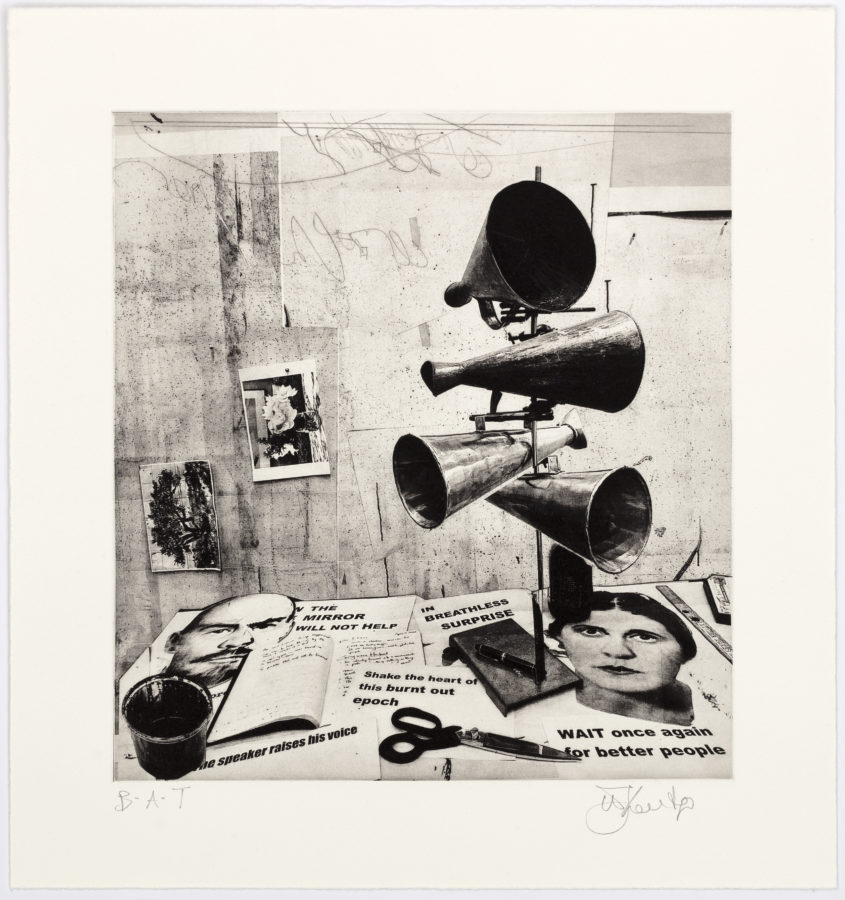The Mirror Will Not Help
The Mirror Will Not Help, a new edition by William Kentridge, forms part of a larger body of work that spirals outwards from Kentridge’s response to Dmitri Shostakovich’s Symphony No. 10, which premiered in 1953 and is often referred to as an insight into the complicated relationship between Shostakovich – and indeed his entire milieu – and the Soviet Union. The Soviet Union has long provided Kentridge fertile ground to experiment with the various ways, often absurd, that the personal and political realms intersect; the influence of the personal on the public and vice versa; and the fragmentary nature of recording and re-telling history.
Kentridge’s response to the symphony took the original form of a single-channel film, Oh To Believe in Another World, that accompanies the live orchestral performance of the symphony, and subsequently expanded into a five-channel film installation. Oh To Believe in Another World is set in what appears to be an abandoned Soviet museum, in which characters that were prominent in Shostakovich’s life and time play out various theatrics, personal and political, and often an amalgamation of both, tracing four decades, from early days of the revolution in 1917 to the death of Stalin in 1953. The film’s protagonists, which include political figures, poets, musicians and their friends, lovers and antagonists, are performed by actors set over by collaged elements, and accompanied by fragmented subtitles. The set of the film, while completely immersive from the viewer’s perspective and seeming to entirely contain the puppet-like actors, is in fact a scale model made using cardboard and paper, which sits on a table top in the artist’s studio.
The Mirror Will Not Help is one of many off-shoots of the film project, featuring the portraits of Lenin and Lilya Brik, the prominent avant-garde figure the early Soviet era, as well as various fragments of text that resonate with the intertitles of the film, and a tower of megaphones that speaks directly to the amalgamation of personal story and public performance into which the film delves. The print is made using photogravure and drypoint, but began its life as a collage. Similar tricks of perception are employed in the collage, which is made up of images of tools used in its own making – a pair of scissors, an ink pot, a journal lying open on a studio table – which are then arranged and collaged on top of more images of the artist’s studio walls and surfaces. The method of the image construction is left open to scrutiny – the distinctive white borders of an image printed out via a desktop printer on A4 office paper are not concealed; the sharp turn of quick-working scissors as they move around a curve is not smoothed over; the cut out and piled up images of the megaphones do not entirely match up, nor are they intended to.
To move the work from its collage form into etching, an photograph of the collage is made into a copper plate from which an etching can be printed using the technique of photogravure. The mark of the artist’s hand is reintroduced at this point in the form of drypoint worked directly onto the copper plate containing the gravure image. In a similar movement between media, the image of the collage was also projected onto a wall and a large scale ink drawing was made onto canvas.
In her recent research into Kentridge’s methodology, Noémia Herdade-Gomes refers to Kentridge’s use of “creative machines” and suggests that this multi-faceted process is Kentridge’s way of “[rethinking] drawing, as an unfinished process, a means of collecting and generating iconography (mediated by different technologies), with the aim of maximising narrative amplitude.” As Kentridge has asserted, the “larger proposition is that one needs to understand history as a form of collage,” and while this rings true on the grand scale of history in the public domain, the same can be asserted for each individual’s personal relationship to that history, and indeed to the telling of one’s own personal history.
Intertitles for the film, appearing during movement I: Moderato of the symphony offer some clues into the concept of layering, fragmenting, and then re-layering that makes up any attempt at meaning-making:
How to Improve and complete the construction of man
The physical. The spiritual
Give the movement of the limbs the utmost precision
Man is at best a semi-manufactured product
My dear homo sapiens I will work on you
| Artist: | William Kentridge |
| Title: | The Mirror Will Not Help |
| More about: | William Kentridge |
| Year: | 2022 |
| Artwork Category:: | Editions & Multiples published by David Krut |
| Media & Techniques: | Direct gravure with drypoint |
| Printer: | Kim-Lee Loggenberg |
| Edition Size: | 36 |
| Sheet Height: | 41.5 cm |
| Sheet Width: | 40 cm |
| Availability: | Available |
| Framing: | Framed |
